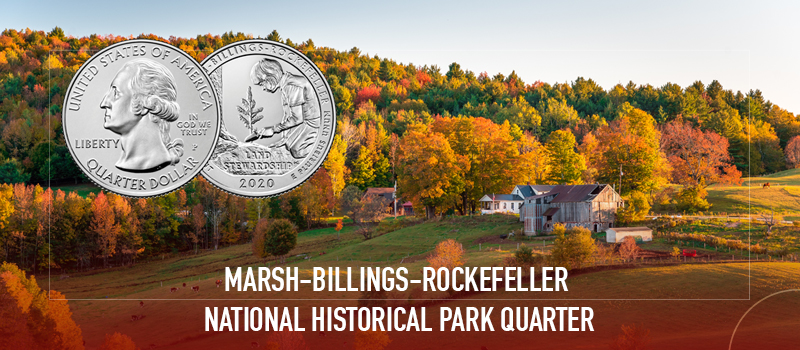Marsh-Billings-Rockefeller National Historical Park Quarter

George Perkins Marsh, one of the first conservationists of America and owner of the Marsh estate, Woodstock, Vermont would be delighted if he came back alive today. The state whose forests were cut in swathes to produce potash and pearlash in the 18th century, has done an about turn and is now known for its rich heritage of conservation. Woodstock, Marsh’s hometown is considered one of the most beautiful in America today.
The 54th quarter of the America the Beautiful series honors the Marsh-Billings-Rockefeller National Historic Park quarter.
George Perkins Marsh – The father of American Conservation Movement
George Marsh saw firsthand how the bountiful forests around his family mansion got removed because of continuous deforestation. The New England countryside bore devastating scars because of growing industries and farms that were becoming commonplace during his formative years. Marsh later became an influential lawyer with expertise in varied subjects and acquired mastery over many languages and cultures. When he was deputed by the U.S. government to Europe, he witnessed the consequences of deforestation there. He feared a similar pattern playing out in the New World.
In 1847, in a Vermont agricultural society he spoke to farmers about the irreversible damage that they were wreaking to the ecology when they cut down trees for farmland. His book ‘Man and Nature’ is considered the first true honest document that spelt out that Earth’s resources were finite, and that man’s actions had irreversible effects on environment.
Frederick Billings’ approach to conservation
Frederick Billings, a Vermonter like Marsh was profoundly influenced by ‘Man and Nature’. He was a lawyer, businessman and conservationist who had made his fortune in the West during the Gold Rush, as a land’s claim lawyer.
When he came back to Vermont, he bought the Marsh estate and started a practical approach to conservation. He created a template for farming, timber harvest and recreation without destroying the land. Along with George Aitkin, an expert in scientific agricultural techniques, Billings initiated innovative dairying and farming practices and reforestation of Mount Tom. He planted hardy European tree species that would thrive in Vermont’s climate. His dairy farm and creamery became one of the best in the country and a blue-print for success for many of the surrounding farms.
The Rockefellers – Continuing the tradition
Laurance Spelman Rockefeller, and Mary French Rockefeller (granddaughter of Billings) continued the tradition of conservation on the estate. Laurance Rockefeller was fascinated with the natural world and was responsible for the establishment of National Parks like Virgin Islands National Park in 1956. When the Rockefellers inherited the Billings farm in 1951, they remodeled and modernized it. They opened the ‘Billings Farm and Museum’ for the public in 1983. In 1992 they donated the estate and the 555 acres of Mount Tom forestland to the National Park service. The Marsh-Billings-Rockefeller National Park opened in 1998.
Marsh-Billings-Rockefeller ATB quarter - The design
The 54th America the Beautiful quarter honoring this National Historical park has a reverse design that shows a young girl completing the planting of a Norway spruce seedling near an established tree, continuing the life cycle of the forest. The girl represents a conservationist advocating the role of humans in maintaining the ecological balance of the environment.
This entry was posted in General on June 26, 2020 by lavanya kannan

Leave a comment